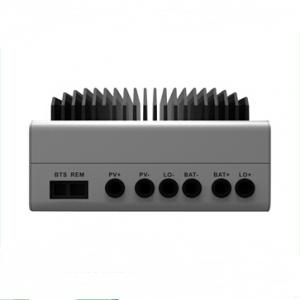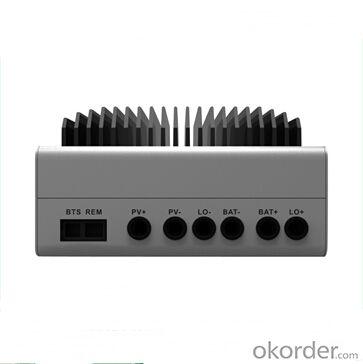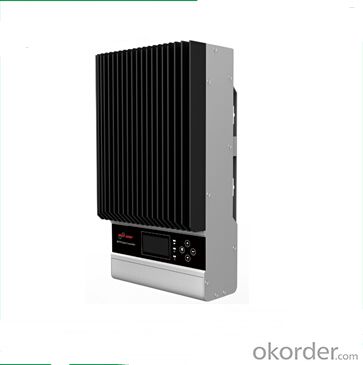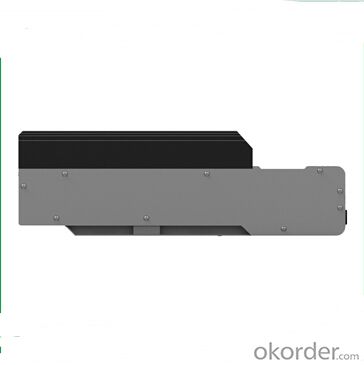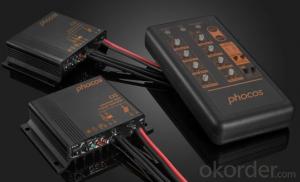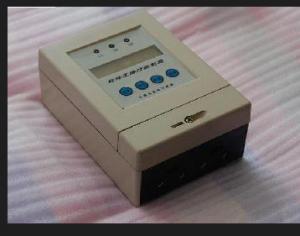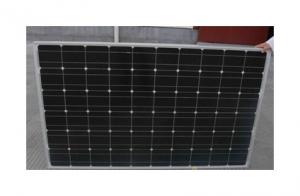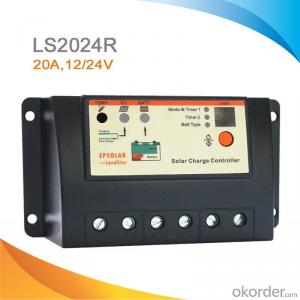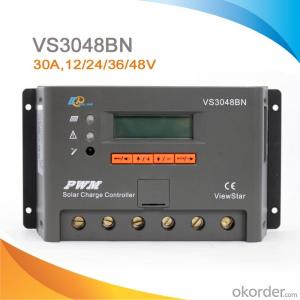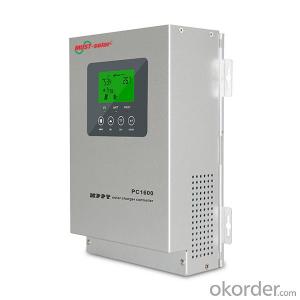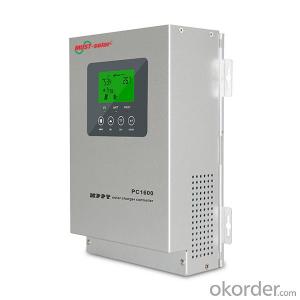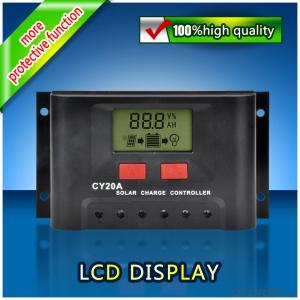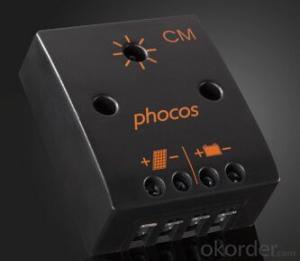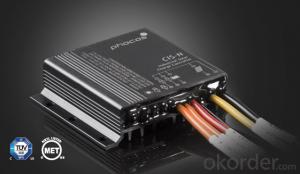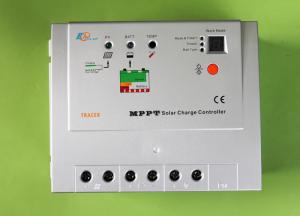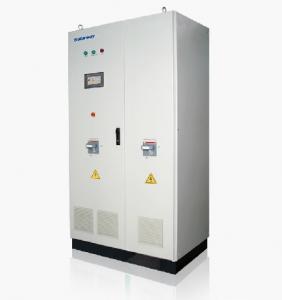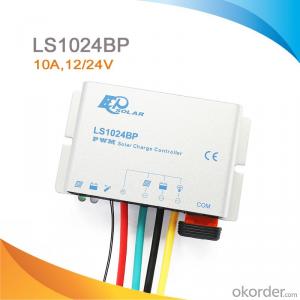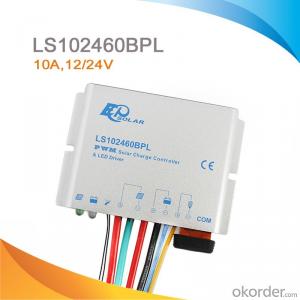Solar Geyser Thermal Controllers PC1600F Series Solar Charge Controller
- Loading Port:
- China Main Port
- Payment Terms:
- TT or LC
- Min Order Qty:
- -
- Supply Capability:
- 10000 unit/month
OKorder Service Pledge
OKorder Financial Service
You Might Also Like
Product Description:
Features:
45A/60A MPPT Solar charge controller
PV input :145V Max
12V/24V/36V/48V auto work
MPPT efficiency>99%,Peak conversion efficiency >98%
DSP processors technology ensure high speed and performance
Four-stages charging mode
Protection: PV array short circuit , PV reverse polarity , Battery reverse polarity , Over charging , Output short circuit
Model | PC1600-1 | PC1600-2 | |
Battery System Voltage | 12V/24V/36V/48 VDC (adjustable) | ||
Charge Input | |||
PV Open Circuit Voltage | Operational max = 145VDC temperature corrected VOC | ||
Max PV Input Power(12V) | 600W | 800W | |
Max PV Input Power(24V) | 1200W | 1600W | |
Max PV Input Power(36V) | 1800W | 2400W | |
Max PV Input Power(48V) | 2400W | 3200W | |
Battery Voltage | |||
Nominal Voltage | 12VDC/24VDC/36VDC/48VDC | ||
Absorption Voltage | 13.5VDC/27.0VDC/40.5VDC/54.0VDC | ||
Refloat Voltage | 13.7VDC/27.4 VDC/41.1VDC/54.8VDC | ||
Float Voltage | 14.3VDC/28.6 VDC/42.9VDC/57.2VDC | ||
Low Voltage Protection Point | 10.5VDC/21.0 VDC/31.5VDC/42.0VDC | ||
DC Output | |||
Output Voltage | 11.0~14.3VDC/22.0~28.6VDC/33.0~42.9VDC/44~57.2VDC | ||
Max Charging Current | 45A amps continuous @ 40°C ambient | 60 amps continuous @ 40°C ambient | |
Warning for low voltage | 11.5VDC/23.0 VDC/34.5VDC/46.0VDC | ||
Cutoff for low voltage | 10.5VDC/21.0 VDC/31.5VDC/42.0VDC | ||
Low voltage recovery | 11.5VDC/23.0VDC/34.5VDC/46.0VDC | ||
Display | |||
LED indication | Systematic operation, LV indication, LV protection, over charge protection, loads protection, short circuit protection | ||
LCD display | Charge voltage, charge current, voltage of battery, capacity of battery, output current | ||
Alarm | PV array short circuit protection, PV reverser polarity protection | ||
Battery reverse polarity protection, Over charging protection | |||
Output short circuit protection | |||
Low voltage protection for storage battery | |||
General specification | |||
Environmental Rating | Indoor | ||
Charge mode | MPPT, PWM, constant current—constant voltage, function of automatic protection for storage battery | ||
Radiating mode | Fan cooling | ||
Working mode | Four stage: Absorption CC, Absorption CV, Float CC, Float CV. | ||
Peak Conversion efficiency | 98% | ||
Environment | |||
Environmental temperature | -25°C ~55°C | ||
Ambient humidity | 0--90%,No condensation | ||
Altitude | ≤3000m | ||
Dimension | |||
W*H* D(mm)/G.W(kg) | 167.6*257.1*82.9mm/3kg | 390*365*364mm(5pcs/carton) | |
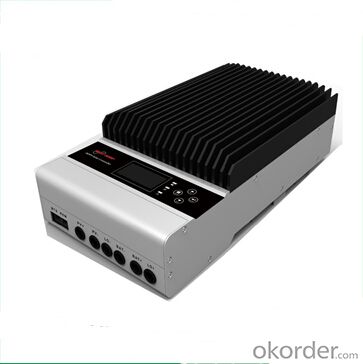
Warrenty
provides a 1~3 year limited warranty (“Warranty”) against defects in materials and workmanship for its Uninterruptible power supply, Power inverter/chargers, Solar charge controllers, Battery Products (“Product”).
The term of this Warranty begins on the Product(s) initial purchase date, or the date of receipt of the Product(s) by the end user, whichever is later. This must be indicated on the invoice, bill of sale, and/or warranty registration card submitted to MUST-Solar. This Warranty applies to the original MUST-Solar Product purchaser, and is transferable only if the Product remains installed in the original use location.
FAQ:
Q1. What is the voltage?
A1. Our 45/60A solar charge controller is 12/24/36/48V auto work.
Q2. What is the difference between MPPT&PWM?
A2. MPPT has higher efficiency, it can track the max power point and won't waste energy.
Q3. What is the efficiency of the MPPT controller?
A3. MPPT>99%, peak conversion efficiency>98%.
Q4. What is the waranty of product?
A4. 12 months.
Q5. What protection does your MPPT controller have?
A5. PV array short circuit, PV reverse polarity, Battery reverse polarity, Over charging, Output short circuit.
- Q: How do PWM solar controllers differ from MPPT controllers?
- PWM solar controllers and MPPT controllers are both used to regulate the charging of batteries in solar power systems, but they differ in their operation and efficiency. PWM controllers work by rapidly switching the solar panel's current on and off, resulting in a pulsating current flow. This type of controller is suitable for smaller solar systems and it regulates the voltage output to match the battery voltage. However, PWM controllers are less efficient compared to MPPT controllers, particularly when there is a significant difference between the solar panel voltage and the battery voltage. On the other hand, MPPT (Maximum Power Point Tracking) controllers are more advanced and efficient. They continuously track the maximum power point of the solar panel, adjusting the voltage and current to ensure maximum power transfer. MPPT controllers are able to convert the excess voltage into additional current, allowing for higher charging efficiency, especially in larger solar installations or when using panels with varying voltages. In summary, while PWM controllers are simpler and more cost-effective for smaller systems, MPPT controllers are more efficient and better suited for larger systems with varying solar panel voltages.
- Q: Can a solar controller be used in a solar-powered irrigation system?
- Yes, a solar controller can be used in a solar-powered irrigation system. The solar controller is responsible for managing and regulating the flow of electricity from the solar panels to the irrigation system, ensuring that the system operates efficiently and effectively.
- Q: How does a solar controller handle fluctuations in solar panel output?
- A solar controller is designed to handle fluctuations in solar panel output by regulating and optimizing the flow of electricity between the solar panels and the battery bank. When solar panels produce more energy than is needed, the solar controller detects the excess and adjusts the charging current flowing into the batteries accordingly. This prevents overcharging and potential damage to the batteries. On the other hand, when solar panel output decreases due to factors like cloud coverage or shading, the solar controller compensates for this by increasing the charging current to maintain the desired charge level of the batteries. This ensures that the batteries are always being charged efficiently, even during periods of reduced solar panel output. To handle fluctuations in solar panel output, solar controllers also incorporate features such as Maximum Power Point Tracking (MPPT) or Pulse Width Modulation (PWM) technology. MPPT controllers continuously monitor and track the maximum power point of the solar panels, adjusting the voltage and current to maximize the energy harvested from the panels. PWM controllers, on the other hand, regulate the charging current by rapidly switching the solar panel output on and off, maintaining a stable voltage and preventing overcharging. Overall, a solar controller acts as a crucial intermediary between the solar panels and the battery bank, ensuring that the energy generated by the panels is efficiently transferred and stored, regardless of fluctuations in solar panel output.
- Q: Can a solar controller be used with solar panels that have different tilt angles?
- Yes, a solar controller can be used with solar panels that have different tilt angles. The solar controller's primary function is to regulate the flow of energy between the solar panels and the battery or load. It does not depend on the tilt angles of the solar panels. However, it is important to note that having different tilt angles may affect the overall efficiency and performance of the solar system.
- Q: How do I choose the right solar controller for my solar panel system?
- To ensure optimal performance and longevity of your solar panel system, it is crucial to choose the right solar controller. Here are some important factors to consider when selecting: 1. System Voltage: Determine the voltage of your solar panels and batteries and find a compatible solar controller. Common voltages include 12V, 24V, and 48V. 2. Maximum Current: Take into account the maximum current generated by your solar panels and select a controller capable of handling that current. Avoid exceeding the controller's maximum current rating to prevent damage. 3. Controller Type: There are three main types of solar controllers: PWM (Pulse Width Modulation), MPPT (Maximum Power Point Tracking), and basic on/off controllers. PWM controllers are suitable for smaller systems, while MPPT controllers are more efficient and recommended for larger systems. 4. Efficiency: Seek a controller with high efficiency ratings to maximize energy harvest from your solar panels, particularly in low light conditions. 5. Load Control: Determine if you need a solar controller that can directly handle loads or if a separate load controller is necessary. Some controllers have built-in load control capabilities, enabling direct power supply to low voltage appliances. 6. Temperature Compensation: If your solar panels will be exposed to varying temperatures, consider a controller with temperature compensation. This feature adjusts charging parameters based on temperature, ensuring optimal charging and battery performance. 7. Protection Features: Ensure the solar controller includes protection features like overcharge, over-discharge, short circuit, and reverse polarity protection. These features safeguard batteries and equipment from damage. 8. Display and Monitoring: Consider controllers with built-in displays for valuable information on system performance and battery status. Some controllers also offer remote monitoring capabilities, allowing you to monitor your system from a distance. 9. Brand Reputation and Warranty: Conduct research on reputable brands known for producing reliable and durable solar controllers. Check warranty information to ensure protection against defects or malfunctions. It is essential to consult with professionals or conduct thorough research before finalizing your decision. They can provide valuable insights and help you select the solar controller that best suits your specific solar panel system requirements.
- Q: Can a solar controller be used with solar panel roof mounts?
- Yes, a solar controller can be used with solar panel roof mounts. The solar controller is responsible for regulating the charge from the solar panels to the batteries, ensuring optimal performance and preventing overcharging. The roof mounts, on the other hand, are used to securely fasten the solar panels to the roof. These two components work together to efficiently harness solar energy and provide power to the desired system.
- Q: Can a solar controller be used with solar panels that are connected in parallel?
- Yes, a solar controller can be used with solar panels that are connected in parallel. The solar controller regulates the voltage and current flow from the solar panels to the battery or grid, regardless of whether the panels are connected in parallel or series.
- Q: Can a solar controller be used with a solar-powered gate opener?
- Yes, a solar controller can be used with a solar-powered gate opener. A solar controller regulates the charging and discharging of the battery in the solar system, ensuring optimal performance and prolonging the lifespan of the battery. It is an essential component for maintaining the efficiency and reliability of a solar-powered gate opener.
- Q: Can a solar controller be used with solar-powered indoor transportation hubs?
- Yes, a solar controller can be used with solar-powered indoor transportation hubs. A solar controller is a device that regulates the flow of electricity from solar panels to batteries or other energy storage systems. In the case of indoor transportation hubs powered by solar energy, a solar controller can be used to manage the energy generated by the solar panels and store it in batteries to be used during low-light conditions or when there is high demand for electricity. This ensures a reliable and consistent power supply for the indoor transportation hub, allowing it to operate efficiently and sustainably. Additionally, a solar controller can also provide important monitoring and protection functions, such as preventing overcharging or over-discharging of the batteries, optimizing energy usage, and ensuring the longevity of the solar power system. Therefore, using a solar controller in conjunction with solar panels can enhance the performance and reliability of solar-powered indoor transportation hubs.
- Q: Can a solar controller be used for battery charging in remote locations?
- Yes, a solar controller can be used for battery charging in remote locations. Solar controllers are designed to regulate and optimize the charging process of batteries using solar panels. They help protect batteries from overcharging and ensure efficient charging even in remote areas where access to electricity might be limited or unavailable. Therefore, solar controllers are ideal for charging batteries in off-grid or remote locations using solar power.
Send your message to us
Solar Geyser Thermal Controllers PC1600F Series Solar Charge Controller
- Loading Port:
- China Main Port
- Payment Terms:
- TT or LC
- Min Order Qty:
- -
- Supply Capability:
- 10000 unit/month
OKorder Service Pledge
OKorder Financial Service
Similar products
Hot products
Hot Searches
Related keywords
